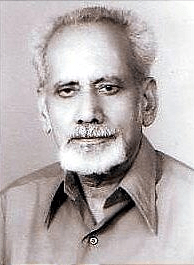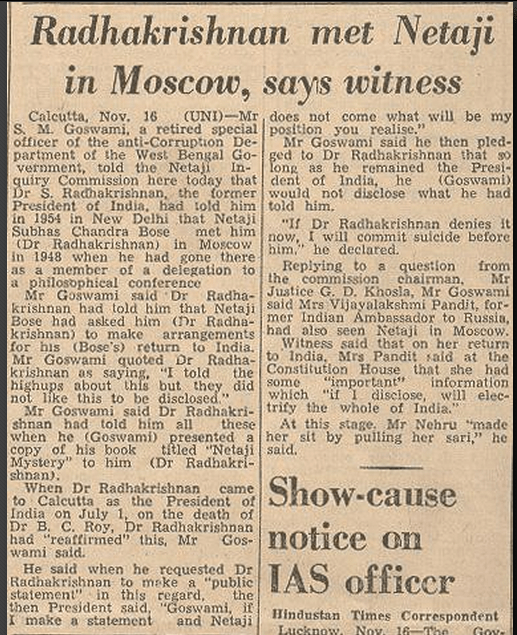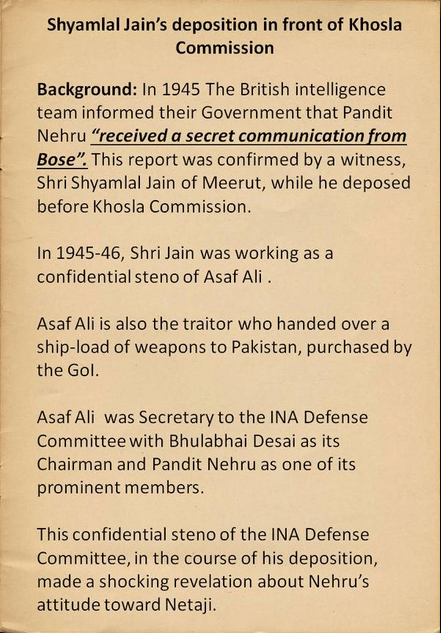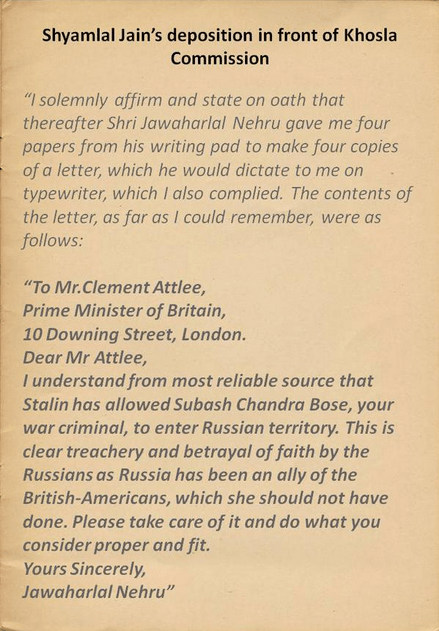5 Reasons why Netaji Bose survived aircash and escaped to Russia

When Netaji Subhash Chandra Bose went looking for help to fight against the British for independence as the Allies were locked in the World War II, he met Hitler. With Adam Von Trott, the translator and Hitler in the room with Bose, Hitler told Netaji that time for India’s Independence struggle wasn’t ripe yet. Netaji immediately retorted “Tell his excellency that I have been in politics all my life and that I don’t need any advice from any side!”, while Hitler was listening in.
Netaji left Germany to its own situation and took Hitler’s submarine to come to Japan instead. Direct, fearless and self-confident – that was Netaji!
In 1971, Usman Patel, Netaji’s bodyguard – who had been denied the opportunity to talk to the first commission formed to inquire into Netaji’s mystery – told Mr. G. D. Khosla of the Khosla Commission – the second one to look into the issue – that Mahatma Gandhi, Jawaharlal Nehru, Mohammad Ali Jinnah and Maulana Azad had come to an agreement with the British that if Netaji were to enter India, he would be handed over and charged. Patel told Khosla that Maulana Azad had confirmed this to him.
So why was someone who so steadfastly kept India’s interest at heart that he could get into a devil’s lair and talk straight to him without fear of retribution; be betrayed so terribly by supposedly the greatest luminaries in Modern India?
What happened to Netaji? There have been three theories:
- Netaji died in the air crash in Taiwan
- Netaji escaped to Russia and died there while in captivity
- Netaji escaped the air crash and also from Russia (Siberia) and died in 1985 while living as Gumnami Baba in India

In this three article series we will look at the mystery of Netaji’s life and death. I want to acknowledge my debt to the most amazing lifetime work by Anuj Dhar, a journalist who was part of the online research work by Hindustan Times and later did his own work to get to the bottom of this mystery. His books “Back from Dead” and “India’s biggest cover up” – are the most detailed seminal works on this subject ever!
Let us look at the type of evidence we have to prove or disprove any theory.
1 Taiwan Government admitted that there was no air crash on August 18, 1945.
The Taiwan Government has informed the one-man Netaji Commission of Inquiry that there was no air crash at Taihoku on August 18, 1945, till date believed to have killed Netaji Subhas Chandra Bose. Disclosing this to newspersons after a routine hearing of the Commission here, Justice M K Mukherjee said that the Taiwan Government has confirmed to the Commission during its recent visit to that country that no plane crashed at Taihoku between August 14 and September 20, 1945.
When Anuj Dhar, the HT journalist followed up with Taiwan on the issue, the reply from the Taiwanese Government was categorical.
“During the period August 14 to October 25, 1945, no evidence shows that one plane had ever crashed at the old Matsuyama Airport (now Taipei Domestic Airport) carrying Mr Subhas Chandra Bose”, Justice Mukherjee said quoting an e-mail sent by Lin Ling-San, Minister of Transportation and Communication, Taiwan government, to Anuj Dhar, a journalist.
The commission, which was provided two e-mails reportedly sent by Taiwanese authorities to Dhar, said “the Mayor of Taipei and the External Affairs Ministry of Taiwan government confirmed us the e-mails to be genuine”.
According to one e-mail, there was no air crash during that period while the other made a reference to a crash on September 20-23, 1945, involving a USC-47 Transporter plane carrying 26 people, most of them believed to be former American POWs just released from camps in the Philippines.
That plane, the e-mail said, crashed on Mount Trident in Taitung area, about 200 nautical miles away from Taipei.
As we have evidence corraborated by the Taiwanese Government itself, at least the story of Netaji died in the aircrash is false, because there was NO aircrash. Surely, it is tough to die in an air crash that never happened.
2Prof. Late Ram Rahul was the Central Asian Studies professor at Jawaharlal Nehru University.

He had a good friend, Rai Singh Yadav who was the Director of the erstwhile Information Service of India, which used to gather intelligence for the ministry. Prof. Rahul had a good friend in Babajan Gouffrav, one of the right-hand man of Josef Stalin. When he came to India, in his discussions with Prof. Rahul, he had talked of the Netaji and how he was in Russia. On his death bed, Prof. Rahul summoned his friend Rai Singh to tell him of the details of his discussions with Gouffrov. He related that Gouffrov had said that “Netaji had crossed over to the Soviet Union in 1945 via Manchuria. As a collaborator of the Axis Powers, he would have been executed. But Josef Stalin wanted to use Netaji as a bargaining chip in his future dealings with Britain and India. Thus, he ordered Netaji’s detention in a labour camp in Siberia”. (Pg 217-218, “Back from Dead” by Anuj Dhar)
In a note to Anuj Dhar later, Late Rai Singh Yadav had said the following about his knowledge of Netaji.
“Netaji had crossed over to the Soviet Union somewhere on the Soviet-Manchurian border, where he was taken into custody by the Soviet Frontier Guards. This was stated by none other than Babajan Gouffrav, a member of the Soviet Union’s Politburo — the highest policy making authority in the Soviet Union. Gouffrav was also the Director of the Institute of the Oriental Studies in Moscow, and a leading member of Uzbek politics. Babajan Gouffrav had visited India several times and was conversant with the political scene in India. He was a close friend of Professor Ram Rahul of Jawaharlal Nehru University in Delhi, who visited Soviet Union Several times, and who I also knew for years.
According to Babajan Gouffrav, India’s Ambassador in Moscow Dr Sarvepalli Radhakrishnan was allowed to see Netaji somewhere in the Soviet Union on the condition that the Ambassador would not talk and mutely converse in any manner with Netaji. After this strange meeting, Ambassador Radhakrishnan informed Prime Minister Nehru about Netaji’s presence in the Soviet Union. This fact came to be known and speculations were rife in New Delhi about the ways and means of securing the release of Netaji from the Soviet custody, but nothing was done at the official level to secure Netaji’s release.”
It is interesting to note that Dr. S. Radhakrishnan, who was a non-descript “leader” until then was suddenly made the Vice President, against the wishes of Maulana Azad, who is said to have retorted to his close aide “Kya hum sab mar gaye hain?” For his loyalty, Dr. Radhakrishnan also got the first ever Bharat Ratna.

So it is clear that despite the lies and deceptions by Dr. Radhakrishnan – who has been raised to the hallowed status of great teacher – Netaji was alive and seen in Russia.
5 Reasons why Netaji Bose survived aircash and escaped to Russia #NetajiFiles #Netaji Click To Tweet
3 Dr Satyanarayan Sinha, a diplomat and Congress MP testified before the Khosla Commission on October 17, 1960. In his testimony before the Commission, under oath, Dr. Sinha said that in 1954 he had met Kuzlov, who was close to Indians during Stalin’s time. This is an excerpt from his deposition before the Committee:
Khosla Commission: I want you to be more specific about this information which you received. Who gave you the information and what were the exact words used by him as far as you can remember?
Sinha: Kuzlov was the name of the man who was connected with the training of Indians till 1934. The same man was later treated by Stalin as a Trotskyist and sent to Yakutsk prison. From there, after the war, he had come back. I met him in Moscow. He said that he had seen Bose in Cell No. 45 in Yakutsk.
Commission: Did he name Bose or did he say some important Indian?
Sinha: He knew Bose. He had been a Soviet agent in India in 30s. He had met Bose in Calcutta and he knew his residence.
Sinha said that he had worked as an interpreter to Radhakrishnan when he was serving in Geneva. Dr. Sinha and Dr. Radhakrishnan had met on the sidelines of the ambassadors’ conference in 1951 in Paris. “He (Radhakrishnan) warned me that I should not meddle in these things. I asked him why. Then he said ‘you will be spoiling your career, you will not be anywhere’.”
4 In his seminal works on this subject – Back from Dead and India’s Biggest Cover Up – Anuj Dhar has laid out the whole case based on evidence from the relevant people who knew what happened. Prof Dr Purabi Roy, formerly of the Department of International Relations, Jadavpur University and of the Asiatic Society of Bengal did extensive research on Netaji and came across many people in Russia who were in the know of things. Most of evidence was available in KGB’s classified documents, which could have been declassified if the Indian Government had asked for it. But no one did. In 1994, Dr. Roy met Alexander Kolesnikov, a former Soviet General who was later part of the Institute of Oriental Studies. Based on her discussions with him and many others who had seen the documents with KGB, the following story emerged. It has been shared by Anuj Dhar in his book “Back from Dead” (pg 214). This is how Netaji escaped to Russia.
The USSR and Subhas Bose were close from a long time, Due to certain circumstances, Netaji had to join the group – the Axis forces – to fight for India’s freedom. But his fight was with the British and USA and not the Soviets. He and Soviets ostensibly still had a liking for each other. As the war was coming to an end and the Japanese were ready for surrender, Netaji wrote to the Soviet ambassador in Japan in late 1944 and meets him in December in order to get safe passage to Russia. Japan’s Government – or at least part of it – was also on board with the plan. As the Red Army enters Manchuria on Aug 9th, Japanese ask Netaji to get ready to move on. Netaji goes to Saigon and meets General Shidei of the Quantung Army which is surrendering to the Red Army. He works with Field Marshal Terauchi to work out the transfer of Netaji to the Russians. The Quantung Army completely surrenders to the General Alexander Vasilevski on Aug 22, 1945. A plane had left on Aug 17th and “reportedly crashed” (a fact rebutted by Taiwanese Government later to Mukherjee Commission). Japanese General Isoda himself told Netaji’s special aide SC Sengupta “Don’t worry, His Excellency Chandra Bose is in safe custody!”
And thus Netaji moved into Soviet Union via Manchuria along with the Red Army, while the story of the aircrash was circulated to camouflage his escape.
5 Now let us move on to another evidence provided to GD Khosla Committee by Shyamlal Jain about what Nehru wrote to British PM Clement Atlee.
Why was the Congress Government, specially Nehru trying so hard to make sure Netaji never surfaced? Because he was in cahoots with the British. To him, Netaji was a “British War Criminal”! Shyamlal Jain, the confidential steno of the INA Defense Committee – which constituted Asaf Ali, Bhulabhai Desai and Jawaharlal Nehru has deposed before the Khosla Committee and had described the contents of the letter that was written by Nehru himself to British PM Clement Atlee. Not only did Nehru describe Netaji as a “British War Criminal” but also said that Stalin’s act of sheltering Netaji was a betrayal and an act of treachery! Interesting indeed, from a man who is supposed to have rather shoddily argued for the INA fighters on trial in Red Fort.


In the subsequent articles of this series, we will discuss what happened to Netaji after he was in Russia.
The second part of this series is 5 Reasons why Gumnami Baba or Bhagwanji was Netaji Himself!

Comments ()